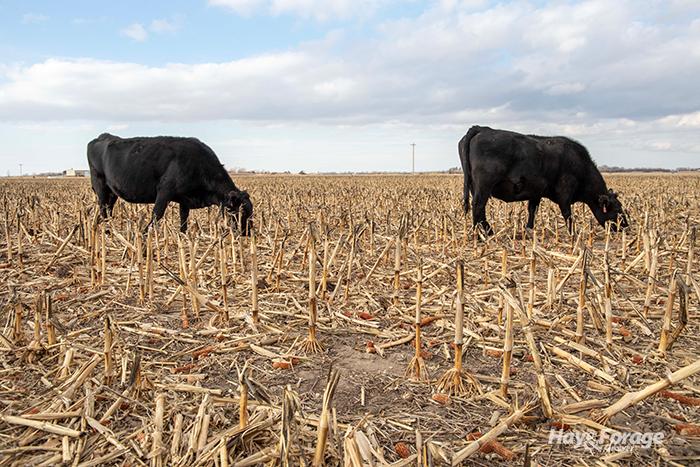Graze cornstalks and sleep well |
| By Mike Rankin, Senior Editor |
|
|
 Crop residues have long provided a cost-effective forage source for feeding animals during late fall, winter, and early spring. Grazing cornstalks tops the list from a popularity standpoint; however, a concern with the practice has always been related to the negative impacts cattle might have on subsequent grain crop production. Specifically, these questions center on soil compaction and nutrient removal. Mary Drewnoski, a University of Nebraska Extension beef systems specialist, reports on a 16-year cornstalk grazing study from her university where both soil compaction and nutrient levels were monitored. The trial showed that soils did not compact when grazing occurred in the fall and early spring. In fact, long-term grazing resulted in higher subsequent corn and soybean yields. From a soil nutrient standpoint, the researchers were not able to measure any significant nutrient drawdown as a result of removing the cornstalks through grazing. “This outcome fits well with expected impacts given that cows in mid-pregnancy retain very little nitrogen, phosphorus, or potassium,” Drewnoski explains. “Cows excrete in manure and urine most of what they consume resulting in very little nutrients being removed from the land.” The beef specialist explains the higher grain yields on grazed cornstalks by noting that there was an improvement in soil microbial biomass in the grazed plots. Don’t push your luck A recent Nebraska study was initiated to test an extreme scenario for spring grazing cornstalks. The thinking was that if grazing was to cause compaction, it was most likely to happen when the soil is wet and thawed and when a high stocking density is used. A field was grazed at the recommended rate of three cows per acre starting in mid-February and lasting for 45 days (normal stocking) or starting in early March with nine cows per acre for 15 days (high stocking). Turn out of the higher stocking density groups was delayed until it rained to achieve the worst-case scenario, and all of the groups were removed in mid-March. According to Drewnoski, there were some minor increases in soil bulk density (measure of compaction) in the grazed plots. The penetration resistance was also higher, resulting in the need for more down pressure on the drill when soybeans were planted. Down pressure applied at planting was 265 pounds in the nongrazed plots and 290 pounds in the grazed treatments. The planting speed was also reduced due to a rougher soil surface. “Much of the increase in penetration resistance is due to the soil having less cover and surface soil moisture.” Drewnoski writes. “However, the subsequent soybean yields were still improved by grazing.” The beef specialist asserts that while it is not recommended to graze late into the spring because it requires some planting adjustments, if cattle happen to be left out when a warm, wet spell occurs, there is no long-term damage to the land. Overall, when managed correctly, grazing corn residue can be a win-win for both the crop and cattle producer, Drewnoski concludes. |
